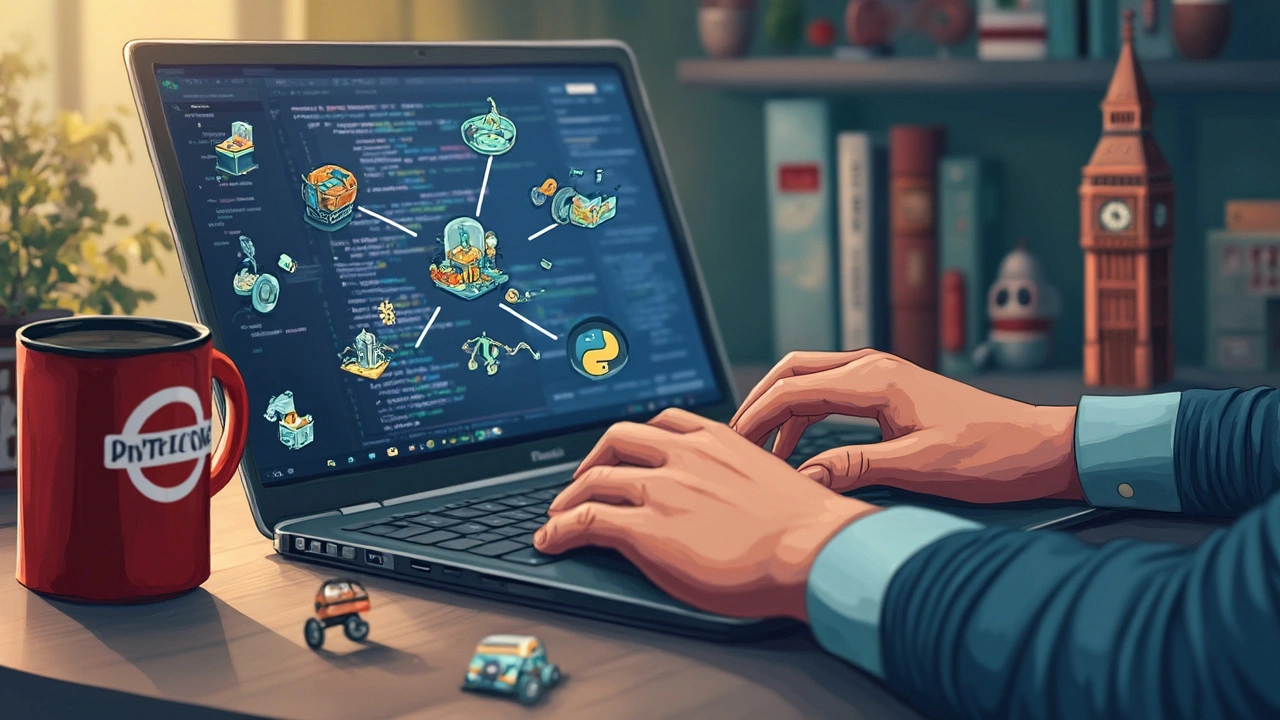Python for AI: Your Gateway to the Next Tech Wave

Think AI is rocket science? Python says nope. The language has taken over pretty much every AI project you hear about, from chatbots to self-driving cars. If you keep hearing about Python in tech circles and wonder why, the answer boils down to its clean code, endless libraries, and a community that's always willing to help.
It's not just big companies like Google or Netflix using Python for AI. Indie developers and students are picking it up because the syntax feels like English and you spend less time wrestling with curly brackets and weird errors. Tools like TensorFlow, PyTorch, and scikit-learn come with plug-and-play solutions for complicated stuff like building neural networks or predicting stock trends. If you’re looking for that "aha" moment in tech, Python is the playground everyone’s joining.
- Why Python Dominates AI
- Must-Know Python Libraries for AI
- How Python Makes AI Projects Easier
- Real Examples: Python in Action
- Tips for Getting Started with AI in Python
Why Python Dominates AI
Python didn't just stumble into the AI scene—it owned it. About 80% of developers working on artificial intelligence now say they use Python for their main projects. And that's not just hype. This language checks off every box that matters for fast-moving tech: it's simple, flexible, and comes with out-of-the-box support for almost any AI problem you want to solve.
The main reason Python leads the pack? It’s the community and the pile of libraries you get without spending years building stuff from scratch. Tools like TensorFlow and PyTorch have entire ecosystems built around them, making even tough tasks like image recognition or voice assistants way less scary. Plus, Python is open-source, so there’s no big price tag to get started—perfect if you’re just testing out ideas from your living room.
- Python for AI is so clear that beginners can pick up machine learning basics after just a few weeks.
- Loads of learning resources—courses, YouTube videos, forums—are centered on Python, so you rarely hit a dead end if you get stuck.
- You can run the same Python code on a laptop, workstation, or even cloud services, making scaling your projects pretty much seamless.
Numbers tell the real story. Here’s how Python stacks up against other languages in AI research over recent years:
| Programming Language | Used in AI Papers (2024) | AI Job Listings (June 2025) |
|---|---|---|
| Python | 78% | 82% |
| R | 8% | 4% |
| Java | 6% | 7% |
| C++ | 5% | 6% |
| Others | 3% | 1% |
What keeps Python rolling strong is how fast you can go from an idea to a working prototype. Want to try a new neural network design at 2 AM? With Python, you just import a few libraries and you’re experimenting in minutes. No wonder everyone from startup founders to bored teenagers is using Python to shape the future of AI.
Must-Know Python Libraries for AI
If you’re diving into Python for AI, start by getting to know the main Python libraries. These are the tools that do most of the heavy lifting, so you don’t have to start from scratch. Without these, building anything smart would take forever.
Here’s a quick cheat sheet of the libraries that power the most popular AI projects:
- NumPy – This is the backbone for crunching numbers. You’ll use it to handle big arrays, matrices, and math operations that show up in pretty much every AI project.
- Pandas – Think of this as your spreadsheet in code. It’s perfect for cleaning, transforming, and analyzing data. If your data’s a mess, Pandas will be your lifesaver.
- scikit-learn – This is the classic pick for machine learning. It’s got tools for training models, testing predictions, and running stuff like regression or classification in a few lines of code.
- TensorFlow – If you want to build neural networks, especially for big projects, this is a go-to. Made by Google, it’s built for scalability. A lot of voice and vision AI tools use TensorFlow.
- PyTorch – Another favorite for deep learning, especially in research or if you want quick prototyping. Many people say it’s easier to pick up than TensorFlow if you’re just getting started.
- Keras – This one helps you build neural networks with less code. It’s like TensorFlow’s friendly wrapper, making everything more user-friendly.
- NLTK & spaCy – If your AI project deals with text (like chatbots, or analyzing tweets), these libraries help you break down language and actually "understand" it with models.
Here’s a look at what developers actually use, based on survey data from 2024:
| Library | % of AI Developers (2024 usage) |
|---|---|
| NumPy | 92% |
| Pandas | 87% |
| scikit-learn | 83% |
| TensorFlow | 66% |
| PyTorch | 61% |
| Keras | 38% |
| NLTK & spaCy | 24% |
These libraries aren’t just for pros. Tons of tutorials and community projects make it easy to find help or working examples. Pro tip—pick a small project and try out a couple of these libraries hands-on. You’ll figure things out a lot faster by experimenting than by reading theory all day.

How Python Makes AI Projects Easier
If you’ve ever struggled with clunky code or weird error messages, you’ll get why Python is the go-to for AI work. Its simple, readable syntax means you write fewer lines and spend more time solving real problems instead of fixing code. Most AI tasks, even the tricky ones, are made much simpler thanks to Python’s clear structure and huge library support.
One big reason developers love Python in the Python for AI world: pre-built libraries. These are ready-to-use chunks of code that help you skip the boring setup and jump straight to modeling, training, and testing. It’s a huge time-saver. You’re not reinventing the wheel every project. Instead, you grab a tool like NumPy for crunching numbers or scikit-learn for machine learning basics, and you’re off to the races.
Here’s something you might not know—Python’s wide adoption in AI led to a huge spike in available tutorials and documentation. If you get stuck, there’s probably a Stack Overflow answer (or ten) ready for you. That’s a safety net you don’t get in every coding community.
Check out this mini-comparison to see how Python stacks up against other AI languages:
| Feature | Python | Java | C++ |
|---|---|---|---|
| Learning Curve | Low | Medium | High |
| Library Support | Extensive | Moderate | Limited |
| Community Help | Excellent | Good | Okay |
| Development Speed | Fast | Slower | Slowest |
That ease-of-use also means you don’t need a supercomputer just to get started. Powerful frameworks like TensorFlow can run on your laptop for basic tasks. And, when you are ready for something bigger, Python fits right in with cloud services like AWS and Google Cloud—no fuss.
To sum up, whatever your AI idea—whether it’s building a robot to pick up your laundry or just sorting your emails—Python makes it less painful and a whole lot more possible.
Real Examples: Python in Action
Python isn’t just the talk of tech meetups. Look at what’s really happening out there. You’ve probably used features powered by Python without even knowing it. Netflix’s recommendation system is built using machine learning models coded in Python. These recommend movies and shows based on what you’ve watched and rated, running through giant pools of user data in milliseconds.
Healthcare is another spot where Python shines. Doctors use AI tools built with Python to scan X-rays for early signs of cancer. Google’s DeepMind used Python while building AI for protein folding, cracking a puzzle scientists struggled with for decades. Talk about game-changing.
If you’ve ever wondered how voice assistants like Alexa get what you’re saying, that’s Python, too. Natural language processing (NLP) libraries like spaCy and NLTK help make these virtual helpers understand and reply to you—sometimes in multiple languages.
- Python for AI is the secret sauce behind Tesla’s Autopilot system, using PyTorch for image and sensor data so cars can see and react to the road.
- Instagram uses Python and Django to manage billions of daily photo uploads, with AI sifting out spam and nasty comments on the fly.
- Spotify’s music recommendation engine is a mashup of Python, math, and user data to serve up your next favorite song.
Here’s a quick look at where Python pops up in the real world:
| Industry | Python AI Use | Impact |
|---|---|---|
| Entertainment | Netflix recommendations | Improved user experience, higher retention |
| Healthcare | Medical image diagnosis | Earlier disease detection, better outcomes |
| Automotive | Tesla self-driving features | Improved road safety, hands-off driving |
| Social Media | Comment moderation on Instagram | Cleaner communities, safer platforms |
| Music | Spotify recommendation system | Personalized playlists, engaged listeners |
If you’re itching to try it out, start small—build a chatbot or a movie recommender using public datasets. You’ll end up using the same libraries major tech companies rely on. That’s how quickly you can get your hands dirty with Python in AI.

Tips for Getting Started with AI in Python
Starting with AI in Python can feel a bit overwhelming, but honestly, it’s all about breaking the process into easy steps and using the right tools. Here’s what you can do to kick things off and actually have fun with it.
- Python for AI is your best bet, so first, make sure you've got Python installed. The latest version (as of June 2025) is Python 3.12, and most AI libraries support it. You can grab it from python.org with a couple of clicks.
- Get comfortable with Jupyter Notebooks. This web-based tool lets you run Python code chunk by chunk, see instant results, and even add notes. If you like learning by doing, Notebooks make it way easier to test ideas without breaking your entire codebase.
- Start with a small project—maybe recognizing doodles with TensorFlow, or making a weather predictor with scikit-learn. Don’t dive straight into building a self-driving car model.
- Don’t ignore documentation. Every time you install a new library (such as pandas, NumPy, or PyTorch), check their official samples and tutorials. They cut debugging time by a mile.
- Check out free online courses. Coursera and edX both offer beginner-friendly Python AI tracks, and they’re loaded with hands-on tasks and sample datasets.
Still worried you'll get lost in the sea of libraries and tools? Here’s a quick reference table showing the most popular libraries, what they’re good for, and how many GitHub stars they had last month:
| Library | Main Use | GitHub Stars (May 2025) |
|---|---|---|
| TensorFlow | Deep learning and neural networks | 181k |
| PyTorch | Flexible machine learning | 99k |
| scikit-learn | Classic machine learning | 63k |
| pandas | Data manipulation | 42k |
| NumPy | Math and arrays | 27k |
Join online forums early. Websites like Stack Overflow, Reddit’s r/learnpython, and GitHub Discussions are where beginners swap advice and solutions fast. If you have a question, someone’s probably already answered it.
Don’t stress if you get stuck—happens to everyone. Just take small steps, experiment a lot, and you’ll start picking up how AI projects actually work. Before you know it, you’ll have some cool projects to show off.